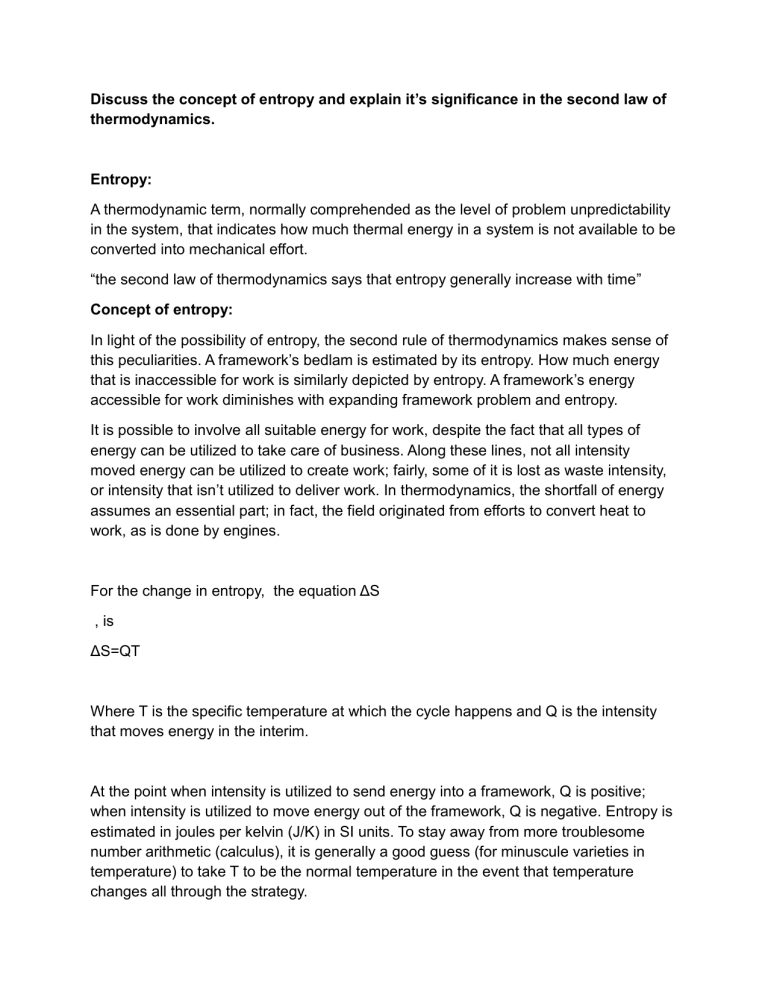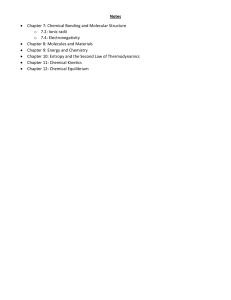
Discuss the concept of entropy and explain it’s significance in the second law of thermodynamics. Entropy: A thermodynamic term, normally comprehended as the level of problem unpredictability in the system, that indicates how much thermal energy in a system is not available to be converted into mechanical effort. “the second law of thermodynamics says that entropy generally increase with time” Concept of entropy: In light of the possibility of entropy, the second rule of thermodynamics makes sense of this peculiarities. A framework’s bedlam is estimated by its entropy. How much energy that is inaccessible for work is similarly depicted by entropy. A framework’s energy accessible for work diminishes with expanding framework problem and entropy. It is possible to involve all suitable energy for work, despite the fact that all types of energy can be utilized to take care of business. Along these lines, not all intensity moved energy can be utilized to create work; fairly, some of it is lost as waste intensity, or intensity that isn’t utilized to deliver work. In thermodynamics, the shortfall of energy assumes an essential part; in fact, the field originated from efforts to convert heat to work, as is done by engines. For the change in entropy, the equation ΔS , is ΔS=QT Where T is the specific temperature at which the cycle happens and Q is the intensity that moves energy in the interim. At the point when intensity is utilized to send energy into a framework, Q is positive; when intensity is utilized to move energy out of the framework, Q is negative. Entropy is estimated in joules per kelvin (J/K) in SI units. To stay away from more troublesome number arithmetic (calculus), it is generally a good guess (for minuscule varieties in temperature) to take T to be the normal temperature in the event that temperature changes all through the strategy. Second law of thermodynamics: Energy is lost increasingly during moves or changes, as indicated by the second law of thermodynamics. Here’s the explanation of significance of entropy in the second law of thermodynamics: As indicated by the second law of thermodynamics, a framework’s all out entropy never diminishes; rather, it either rises or stays consistent during any unconstrained movement. This regulation has a huge ramifications: heat normally moves energy from objects with higher temperatures to those with lower temperatures, however it never does so precipitously in the alternate manner. The justification behind this is on the grounds that when energy is moved from a hot to a chilly temperature, entropy climbs. At lower temperatures (more modest T), there is a more noteworthy change in ΔS on the grounds that the adjustment of entropy is Q/T. Subsequently, the framework encounters a general ascent in entropy due to the more sultry (bigger T) item’s entropy decline being not exactly the colder (more modest T) article’s entropy increment. Here is one method for seeing it: heat can’t be the main result of any activity, moving energy from a cooler thing to a more smoking one. Because of the framework’s all out entropy diminishing, heat can’t unexpectedly move energy from colder to more smoking. In addition to the fact that entropy is a proportion of turmoil, however it is likewise associated with the absence of accessible energy for work. An extremely requested and organized arrangement of water particles, for example, changes into a scattered fluid with no decent sub-atomic positions when an ice block liquefies.







